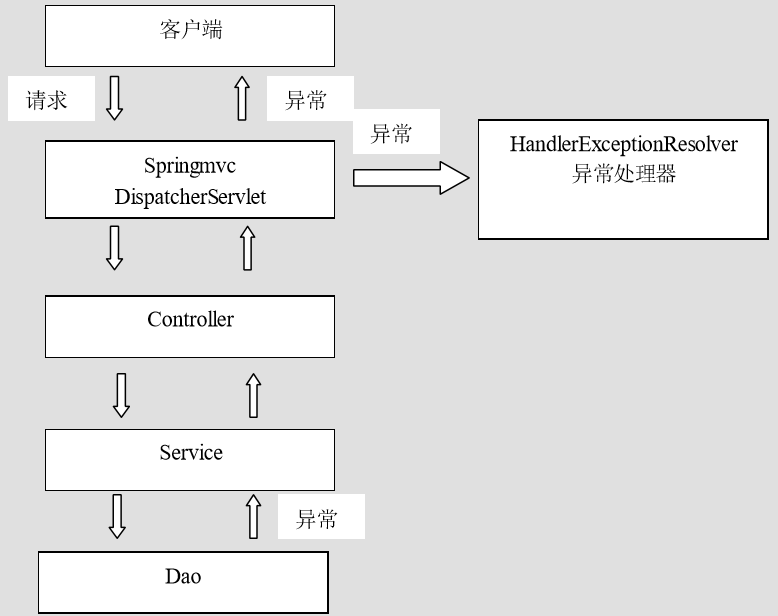异常处理的思路
系统中异常包括两类:预期异常和运行时异常 RuntimeException,前者通过捕获异常从而获取异常信息, 后者主要通过规范代码开发、测试通过手段减少运行时异常的发生。
系统的 dao、service、controller 出现都通过 throws Exception 向上抛出,最后由 springmvc 前端 控制器交由异常处理器进行异常处理,如下图:

SpringMVC的异常处理实现步骤

1. 编写index、success、error三个页面
index.jsp <body> <h3>异常处理</h3> <a href="user/testException" >异常处理</a> </body> ============================ success.jsp <body> 成功! </body> ============================ eeror.jsp <%@ page contentType="text/html;charset=UTF-8" language="java" isELIgnored="false" %> <html> <head> <title>Title</title> </head> <body> ${errorMsg} </body> </html>
2. 自定义异常类和自定义异常处理器
/** * 自定义异常类 */ public class SysException extends Exception{ //存储提示信息 private String message; public SysException(String message){ this.message = message; } public String getMessage() { return message; } public void setMessage(String message) { this.message = message; } } =========================== /** * 自定义异常处理器 */ public class SysExceptionResolver implements HandlerExceptionResolver { /** * 处理异常业务逻辑 */ @Override public ModelAndView resolveException(HttpServletRequest request,
HttpServletResponse response,Object o, Exception ex) { //获取到异常对象 SysException e = null; if (ex instanceof SysException){ e = (SysException)ex; }else{ e = new SysException("系统正在维护。。。"); } //创建ModelAndView对象 ModelAndView mv = new ModelAndView(); mv.addObject("errorMsg",e.getMessage()); mv.setViewName("error"); return mv; } }
3. 在springmvc.xml中配置异常处理器

<?xml version="1.0" encoding="UTF-8"?> <beans xmlns="http://www.springframework.org/schema/beans" xmlns:mvc="http://www.springframework.org/schema/mvc" xmlns:context="http://www.springframework.org/schema/context" xmlns:xsi="http://www.w3.org/2001/XMLSchema-instance" xmlns:mv="http://www.springframework.org/schema/mvc" xsi:schemaLocation=" http://www.springframework.org/schema/beans http://www.springframework.org/schema/beans/spring-beans.xsd http://www.springframework.org/schema/mvc http://www.springframework.org/schema/mvc/spring-mvc.xsd http://www.springframework.org/schema/context http://www.springframework.org/schema/context/spring-context.xsd"> <!--配置spring创建容器时要扫描的包--> <context:component-scan base-package="com.churujianghudezai"></context:component-scan> <!--配置视图解析器--> <bean id="viewResolver" class="org.springframework.web.servlet.view.InternalResourceViewResolver"> <property name="prefix" value="/WEB-INF/pages/"></property> <property name="suffix" value=".jsp"></property> </bean> <!--配置自定义的异常处理器--> <bean id="sysExceptionResolver" class="com.churujianghudezai.exception.SysExceptionResolver"/> <!--配置spring开启注解mvc的支持--> <mvc:annotation-driven ></mvc:annotation-driven> </beans>
4. 编写控制器
@Controller @RequestMapping("/user") public class UserController { @RequestMapping("/testException") public String testException() throws SysException{ System.out.println("testException执行了。。。"); try{ //模拟异常 int a = 10/0; }catch(Exception e){ //打印异常信息 e.printStackTrace();; //抛出自定义异常信息 throw new SysException("查询所有用户出现异常。。。"); } return "success"; }
}

